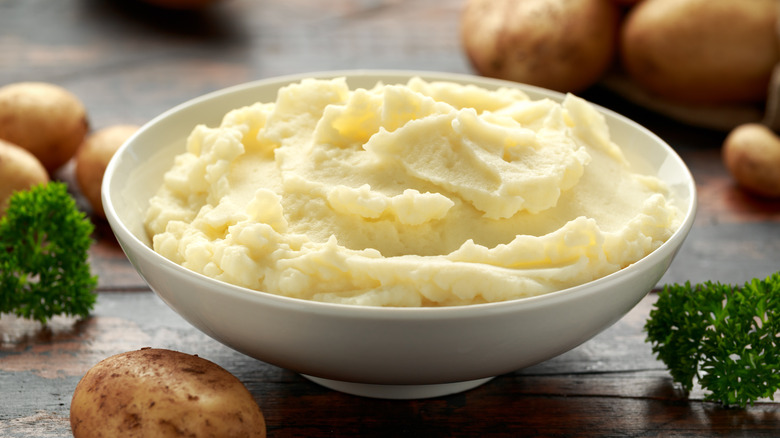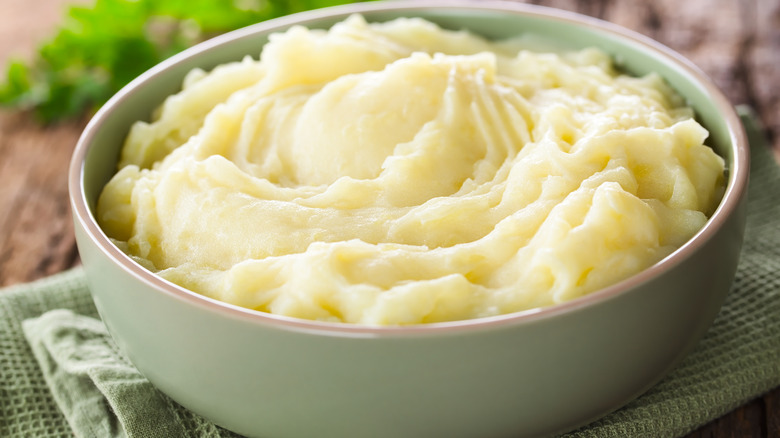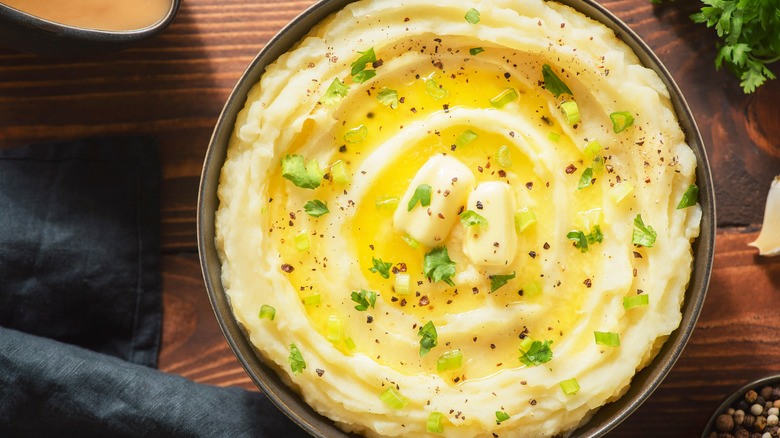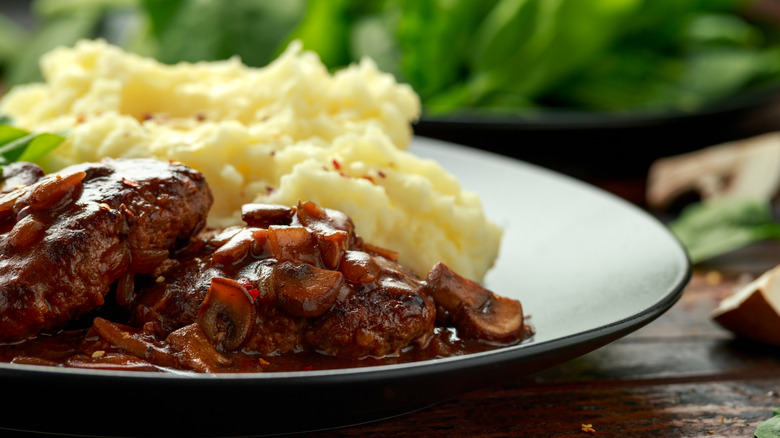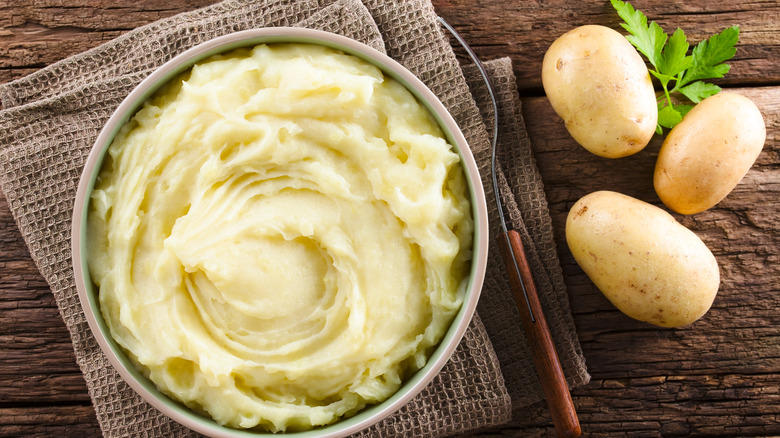You've Been Reheating Mashed Potatoes Wrong Your Whole Life
Mashed potatoes are a staple of most dinners. If it's served with meatloaf or a hunk of fried chicken, drenched in creamy country gravy, or loaded up with cheese and bacon, there's something about that warm and buttery side dish that conjures up the image of a home-cooked American dinner. There's a variety of ways to ensure that your bowl of mashed spuds will always come out creamy and smooth every time. Andrew Rea of Binging with Babish fame suggests you run the potatoes through a ricer to ensure they come out lump-free and prevent overworking the starch. Bon Appetit recommends boiling your potatoes in larger chunks to avoid water soaking into them and draining them of flavor, as well as adding aromatics like rosemary and thyme to boost their flavor profile. There are many ways to make fresh, delicious, hot mashed potatoes that will have everyone scraping the bottom of the bowl for more.
But, reheating your mashed potatoes? That's a different story. You put a bowlful in the microwave, and what was once warm, fluffy mashed potatoes have been reduced to watery, chunky paste that's somehow still frozen in the middle. Is there any way you can enjoy those leftover tubers from last night's dinner without having to throw them out? According to MyRecipes, there's more than one way to make sure that those reheated mashed potatoes will taste almost as fresh as they did off the stove.
The Double Boiler Method
You've probably heard of double boilers before, especially if you're in the business of confections. Double boilers are commonly used to melt chocolate or help keep certain "delicate" dishes warm in a very gentle and careful manner, per The Spruce Eats. While you could purchase a double boiler from just about any place that sells kitchen equipment, it's very easy to improvise at home. According to MyRecipes, this is a good way to reheat mashed potatoes without drying them out.
One should first fill a pan or a pot with water and allow it to simmer, then place a heat-proof bowl on top of it. Add your cold mashed potatoes and frequently stir, adding room temperature milk and/or butter, using the steam from the water to reheat the pre-cooked potatoes. It is, however, advised not to stir constantly as this will result in the potatoes getting a glue-like texture. Once the potatoes are sufficiently warmed, they are once again ready to serve. While you may have some doubts about using a double boiler, it has many perks. You can control the amount of heat and steam, lowering your risk of burning your potatoes (via Fine Cooking).
The Oven Method
If you're still not sold on a double boiler, you'll be happy to know you can use the inside of your oven to reheat potatoes just as you would any other type of food. The drawback, however, is that it's not as quick as heating them on the stovetop or in the microwave, taking about 30 minutes to prepare. Southern Living and The Pioneer Woman also recommend this method, explaining that the oven method not only prevents the loss of moisture that would occur in a microwave but also allows you to add certain flavors such as cheese or sour cream during the reheating process.
First, one should add their cold mashed potatoes, milk, and butter into a well-buttered, oven-safe container. The container should be covered in foil and then placed into a 325-degree oven. Throughout the next 30 minutes, the potatoes must be checked frequently, so one can't simply put them in and leave. If the potatoes seem to be looking dry, more milk and butter should be added. If the potatoes are cold in some spots or the butter isn't spreading, give them a quick stir. While this is a pretty lengthy method to reheat your mashed potatoes, it will yield a far more consistent and creamier taste than simply tossing them in the microwave.
The Microwave Method
Although reading these methods may cast the microwave in a bad light, it's still a very good way to reheat your leftovers. There's also a very simple way to avoid getting those half-frozen and glue-like mashed potatoes.
Fill up a microwave-safe bowl with your cold mashed potatoes and some butter, as you usually would. Place a microwave-safe plate on top of the bowl and then microwave for 15 seconds, removing the plate and then stirring the potatoes. Repeat this microwaving process in short bursts and stir until the potatoes are warm. The plate will help prevent moisture loss, although more butter can be added if need be. Surprisingly, or unsurprisingly to those who view the microwave as an illegitimate kitchen tool, this method isn't viewed in a very popular light, but more as a "last resort" option. Clean Green Simple said that while it was the quickest option, it's an incredibly finicky process that could result in perfect potatoes, dried flavorless lumps, or gummy, soupy paste. CNET offers some advice on how to ensure your potatoes — and other foods — can be reheated without ruining them, such as adjusting the temperature and ensuring your food is spread out for even heating.
The Make-Ahead Method
"Make them ahead? Why would I want to go through the whole thing again when I want some mashed potatoes now?" you ask yourself. While it's true this isn't technically a method for reheating your mashed potatoes, it's more along the lines of making mashed potatoes quickly and easily at any given moment.
One should first cube or rice the potatoes, boiling them over the stove and then refrigerating them. When the time comes to prepare your mashed potatoes, remove the pre-prepared dish and, in a pan over low heat, add hot milk, cream, and butter until the potatoes are mashed. You could have fresh mashed potatoes in only a few minutes using this method. Bon Appetit recommends heating the milk and cream first while putting the potatoes and butter through a ricer to keep the potatoes as smooth as possible. Simply Recipes also offers a variant on this technique, using cream cheese and yogurt to ensure the potatoes are extra creamy, and then baking the dish in the oven to give it a light golden brown crust.
While there are many different methods to reheating your potatoes to taste as fresh as can be, nothing truly beats the first taste of rich, fluffy, creamy mashed potatoes alongside warm, savory gravy.
